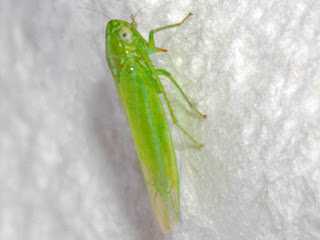Cinnabar, Burnham Overy, 20th April
There were also some Brown-tail caterpillars though I didn't notice if the sea buckthorn clump was infested with them like it is most years - I think I would have noticed if there had been as many as there often are.
Brown-tail larvae, Burnham Overy, 20th April
I caught a Hazel Slender Parornix devoniella in the garden on Friday afternoon, my first this year, and another new moth for the year was on the trap when I went out to look in the evening, Oak-tree Pug. Other moths that night were Shoulder Stripe, Brindled Pug, 2 Brindled Beauties, Cinnabar and 9 Hebrew Characters. Also another Ophion obscuratus.
Hazel Slender (female, gen det), North Elmham, 21st April
Oak-tree Pug (male, gen det), North Elmham, 21st April
I had a good morning's birding in the Broads on Saturday which included my first Large White butterfly of the year and Green Tiger Beetles, along with what I think was my first Early Wintercress (aka Middle-flowered Wintercress). After this I headed back to my local patches pausing for a bit at Honeypot Wood on the way. There was a sunny sheltered edge that was heaving with insect-life. There were tonnes of hoverflies, the majority of which I'm afraid I ignored (there's a limit to how many different insects I can take home to identify!), although I did manage to identify Leucozona lucorum from a photo. I also ignored the bees and most of the flies, though among the latter were lots (easily 20) of Dark-edged Bee-flies. Butterflies included Orange-tips, Peacock, Red Admiral and Speckled Wood.
It was along here that I found numerous tiny moths flying around which I did not recognise. They recalled Feathered Bright Incurvaria masculella in their pattern, but in case there was any doubt that these were much smaller I accidentally netted a male Incurvaria maculella while I was trying to catch one of the smaller moths - it dwarfed them. They were also consistently paler grey and I new they had to be something different. A quick text to Dave came back with the suggestion of Heliozela, a genus in an entire family that has somehow escaped my attention thus far despite not being especially unusual (though the majority of records are mines not adults). He was bang on the money: they proved to be Oak Satin Lifts Heliozela sericiella - at least 20 of them. Their restless habits and shiny scales made them a nightmare to photograph - here are my best efforts.
Oak Satin Lifts Heliozela sericella (males, gen det), Honeypot Wood, 22nd April
I thought this Phyllonorycter might be kleemanella as the third dorsal and costal strigilae didn't meet but its genitalia rule that out - thus it must be another Red Hazel midget Phyllonorycter nicellii.
Red Hazel Midget Phyllonorycter nicellii (male, gen det), Honeypot Wood, 22nd April
Other moths there included Plain Gold Micropterix calthella, Large Long-horn Nematopogon swammerdamella and Common Nettle-tap Anthophila fabriciana.
Some beetles on Dandelions eventually proved to be Byturus ochraceus, a species I had not identified before although the resources I used to identify them allowed me to confirm an individual I had previously photographed and left at Byturus sp.
Byturus ochraceus, Honeypot Wood, 22nd April
Another beetle was a lifer, the weevil Barynotus moerens. There were also two Pollen Beetles Meligethes sp. but I was unable to get a positive ID to species level on these two (they were most likely aeneus but I wasn't convinced they were both the same species).
Barynotus moerens, Honeypot Wood, 22nd April
I did retain one fly that I thought might be distinctive enough to identify with my limited resources, but alas it is not so, at least not with confidence. At first I thought it was going to be one of the Chlorops species but in the end I think it was probably the Yellow Swarming Fly Thaumatomyia notata. Any correction/confirmation would be welcome.
possible Thaumatomyia notata, Honeypot Wood, 22nd April
Now joined by Dave we headed to the patch where one site produced Hawthorn Slender Parornix anglicella, 2 White-bodied Midgets Phyllonorycter joannisi, 100 Horse Chestnut Leaf-miners Cameraria ohridella and Least Black Arches. I recorded joannisi on Norway Maple trunks here in the excellent Phyllonorycter year of 2014 but hadn't been able to find them since so good to know this attractive and relatively scarce species is still around. Although the large numbers of Horse Chestnut Leaf-miners were not themselves of much interest, perhaps the ease with which they were found on tree trunks may indicate it will be another reasonably good year for finding leaf-miner adults? Let's hope so...
White-bodied Midget Phyllonorycter joannisi, Bittering, 22nd April
We found quite a few Whiteflies (Aleyrodidae) here too, though I have no idea how to identify them to species level.
Not much variety in the moth trap that night - 2 Muslin Moths and 19 Hebrew Characters. Also another Ophion obscuratus (ichneumon wasp).
Next day I found a Small Purple and Gold (aka Mint Moth) Pyrausta aurata on the patio doors, my first this year.
Small Purple and Gold Pyrausta aurata, North Elmham, 23rd April
There were more moths in the trap that night than I expected given the cool temperatures: 3 Brindled Beauties, Lesser Swallow Prominent, 2 Muslin Moths, 12 Hebrew Characters and another Mullein. The Prominent was new for the year.
Lesser Swallow Prominent, North Elmham, 23rd April
With Arctic conditions now pushing firmly into the county I wasn't surprised to find just 1 Muslin Moth and 5 Hebrew Characters (and 2 Common Earwigs) in the trap last night.
I found this Tawny Mining Bee in the garden today - technically a new species for me though I'm sure I've seen them in the past before I was keeping records of such things.
Tawny Mining Bee Andrena fulva, North Elmham, 25th April































































